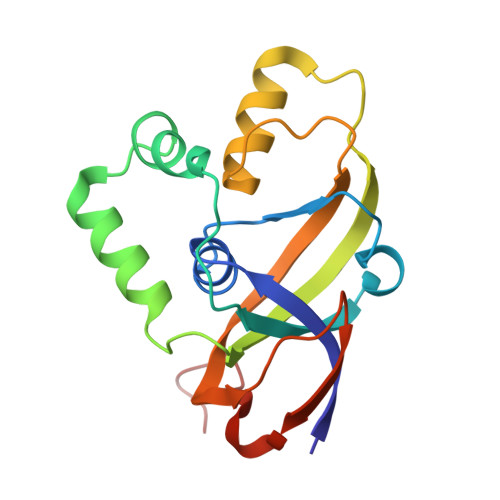Crystal Structure of Human EOLA1 Implies Its Possibility of RNA Binding.
Kim, M., Park, S.H., Park, J.S., Kim, H.J., Han, B.W.(2019) Molecules 24
- PubMed: 31569543
- DOI: https://doi.org/10.3390/molecules24193529
- Primary Citation of Related Structures:
5Y7D - PubMed Abstract:
Human endothelial-overexpressed lipopolysaccharide-associated factor 1 (EOLA1) has been suggested to regulate inflammatory responses in endothelial cells by controlling expression of proteins, interleukin-6 and vascular cell adhesion molecule-1, and by preventing apoptosis. To elucidate the structural basis of the EOLA1 function, we determined its crystal structure at 1.71 Å resolution and found that EOLA1 is structurally similar to an activating signal cointegrator-1 homology (ASCH) domain with a characteristic β-barrel fold surrounded by α-helices. Despite its low sequence identity with other ASCH domains, EOLA1 retains a conserved ' G x K xx E x R ' motif in its cavity structure. The cavity harbors aromatic and polar residues, which are speculated to accommodate nucleotide molecules as do YT521-B homology (YTH) proteins. Additionally, EOLA1 exhibits a positively charged cleft, similar to those observed in YTH proteins and the ASCH protein from Zymomonas mobilis that exerts ribonuclease activity. This implies that the positively charged cleft in EOLA1 could stabilize the binding of RNA molecules. Taken together, we suggest that EOLA1 controls protein expression through RNA binding to play protective roles against endothelial cell injuries resulting from lipopolysaccharide (LPS)-induced inflammation responses.
Organizational Affiliation:
Research Institute of Pharmaceutical Sciences, College of Pharmacy, Seoul National University, 1 Gwanak-ro, Gwanak-gu, Seoul 08826, Korea. mkim13@snu.ac.kr.

















